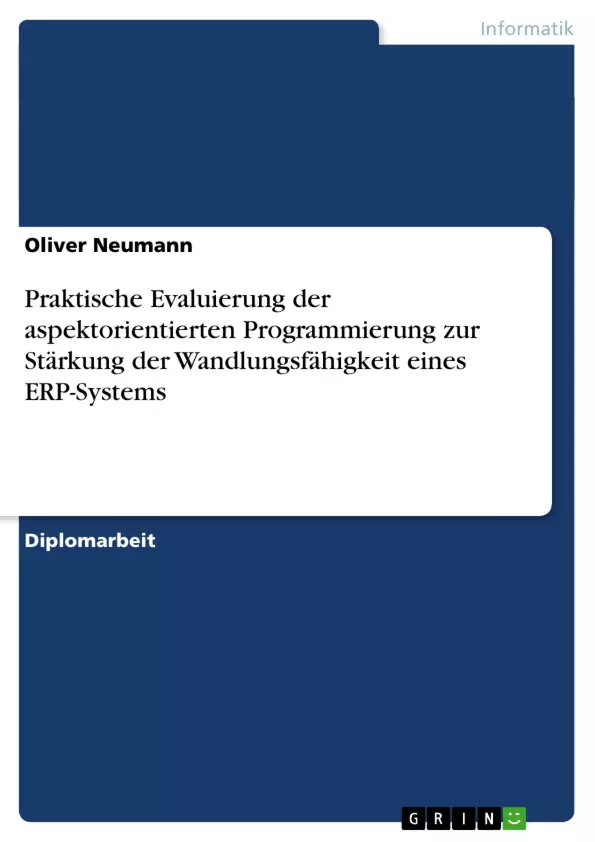Eine Software, welche in die betrieblichen Prozesse eingebunden ist, erfordert einen
möglichst hohen Grad an Wandlungsfähigkeit, um sich schnell und ezient den dynamischen Prozessen anpassen zu können. Eine Erhöhung der Wandlungsfähigkeit von ERPSystemen ist die Bestrebung zahlreicher Forschungsinstitute und ERP-System-Anbieter.
Dem gegenüber steht in der Softwareentwicklung der Wunsch nach mehr Flexibilität
und Modularität. Eine Entwicklung die dieses Ziel verfolgt, ist die der spektorientierten
Programmierung (AOSD - Aspect Oriented Software Development).
Diese Arbeit stellt den Versuch dar, die beiden genannten Elemente vorteilhaft zu verknüpfen. Dazu wird die Wandlungsfähigkeit eines Open-Source-ERP-Systems untersucht, um anschließend die positiven Einüsse bei der Verwendung von Aspektorientierung im Sinne der Wandlungsfähigkeit aufzuzeigen. Als Grundlage dient dabei das Java-basierende Open-Source-ERP-System Compiere. Unter Verwendung des aspektorientierten Programmiermodells ObjectTeams wird dieses im Verlauf dieser Arbeit mit Aspekten angereichert werden. Die Erweiterung zielt hierbei auf eine Stärkung einzelner Kriterien der Wandlungsfähigkeit ab, um dadurch eine Steigerung der Gesamtwandlungsfähigkeit zu erreichen.
Inhaltsverzeichnis
- 1 Einleitung
- 1.1 Motivation
- 1.2 Struktur
- 2 Enterprise Resource Planning
- 2.1 Begriffsklärung und Aufgabendefinition
- 2.2 Entstehungsgeschichte
- 2.3 Enterprise Systeme
- 2.4 Aufbau eines ERP-Systems
- 2.5 Open-Source in unternehmensweiten Anwendungen
- 3 Wandlungsfähigkeit
- 3.1 Begriffsklärung
- 3.2 Wandlungsfähige ERP-Systeme
- 3.2.1 Kriterien der Wandlungsfähigkeit
- 3.2.2 Wandlungsfähige Architekturmodelle
- 3.2.3 Ermittlung der Wandlungsfähigkeit
- 3.2.4 Auswertung der Wandlungsfähigkeit
- 3.2.5 Bedeutung der Wandlungsfähigkeit für ERP-Systeme
- 4 Compiere
- 4.1 Funktionalitäten
- 4.1.1 Quote-to-Cash.
- 4.1.2 Requisition-to-Pay
- 4.1.3 Customer-Relations-Management (CRM)
- 4.1.4 Partner-Relations-Management
- 4.1.5 Supply-Chain-Management (SCM)
- 4.1.6 Performanz Analyse
- 4.1.7 Web-Store
- 4.1.8 Workflows
- 4.1.9 Zusammenfassung.
- 4.2 Aufbau und Struktur
- 4.2.1 Technische Anforderungen
- 4.2.2 Applikationsstruktur
- 4.2.3 Datenbankstruktur
- 4.2.4 Datenbankzugriff
- 4.2.5 Grafische Abbildung der Datenbank
- 4.1 Funktionalitäten
- 5 Aspektorientierte Softwareentwicklung
- 5.1 Begriffsklärung und allgemeine Übersicht
- 5.1.1 Problematik
- 5.1.2 Elemente der Aspektorientierung
- 5.1.3 Verwebung.
- 5.1.4 Die Vor- und Nachteile der Aspektorientierung.
- 5.1.5 AOP-Implementierungen für Java
- 5.2 JBoss AOP
- 5.2.1 Das Pointcut-Modell
- 5.2.2 Verwebung und Deployment von Aspektklassen
- 5.3 Object Teams
- 5.3.1 Rollenbasierte Programmierung
- 5.3.2 Kollaborationen
- 5.3.3 Teams
- 5.3.4 Rollen
- 5.3.5 Modellierung aspektorientierter Anwendungen
- 5.3.6 Translations-Polymorphismus
- 5.1 Begriffsklärung und allgemeine Übersicht
- 6 Compiere Monitor
- 6.1 Aspektorientierung in Compiere
- 6.2 Zielsetzung
- 6.3 Funktionalitäten
- 6.4 Die Compiere-Aspektgeneratoren
- 6.4.1 Aspektklassen
- 6.4.2 Aspektkonfiguratoren
- 6.5 Verwendete Techniken
- 6.6 Datenbankmodell
- 6.7 Implementierung
- 6.7.1 Allgemeine Konzepte
- 6.7.2 Design Patterns
- 6.8 Zusammenfassung.
- 7 Ergebnis und Zusammenfassung
- 7.1 Evaluierung der Wandlungsfähigkeit von Compiere
- 7.1.1 Ermittlung der Einflüsse des Compiere Monitor
- 7.1.2 Ergebnisportfolio
- 7.2 Zusammenfassung und Ausblick
- 7.1 Evaluierung der Wandlungsfähigkeit von Compiere
Zielsetzung und Themenschwerpunkte
Diese Diplomarbeit untersucht die Verwendung der aspektorientierten Programmierung (AOP) zur Verbesserung der Wandlungsfähigkeit eines Enterprise Resource Planning (ERP)-Systems. Das Ziel ist es, zu analysieren, inwiefern AOP zur Stärkung der Flexibilität und Anpassungsfähigkeit eines ERP-Systems beitragen kann.
- Wandlungsfähigkeit von ERP-Systemen
- Aspektorientierte Programmierung (AOP)
- Anwendungen von AOP in ERP-Systemen
- Evaluierung der Wandlungsfähigkeit durch AOP
- Implementierung eines AOP-basierten Monitoringsystems für Compiere
Zusammenfassung der Kapitel
Die Einleitung stellt die Motivation und Struktur der Arbeit dar. Kapitel 2 erläutert das Konzept des Enterprise Resource Planning und die Herausforderungen der Wandlungsfähigkeit in ERP-Systemen. Kapitel 3 beleuchtet den Begriff der Wandlungsfähigkeit und die Bedeutung für ERP-Systeme. Kapitel 4 stellt das Open-Source-ERP-System Compiere vor und erläutert seine Funktionalitäten und Architektur. Kapitel 5 präsentiert die aspektorientierte Softwareentwicklung, einschließlich ihrer Konzepte, Vorteile und Nachteile, sowie gängige Implementierungen wie JBoss AOP und Object Teams. Kapitel 6 beschreibt die Implementierung eines AOP-basierten Monitoringsystems für Compiere, den Compiere Monitor. Kapitel 7 fasst die Ergebnisse der Arbeit zusammen und bewertet die Auswirkungen des Compiere Monitors auf die Wandlungsfähigkeit von Compiere.
Schlüsselwörter
Enterprise Resource Planning (ERP), Wandlungsfähigkeit, Aspektorientierte Programmierung (AOP), Open-Source, Compiere, Compiere Monitor, Flexibilität, Anpassungsfähigkeit, Softwareentwicklung, Evaluierung.
- Quote paper
- Oliver Neumann (Author), 2006, Praktische Evaluierung der aspektorientierten Programmierung zur Stärkung der Wandlungsfähigkeit eines ERP-Systems, Munich, GRIN Verlag, https://www.hausarbeiten.de/document/80641


